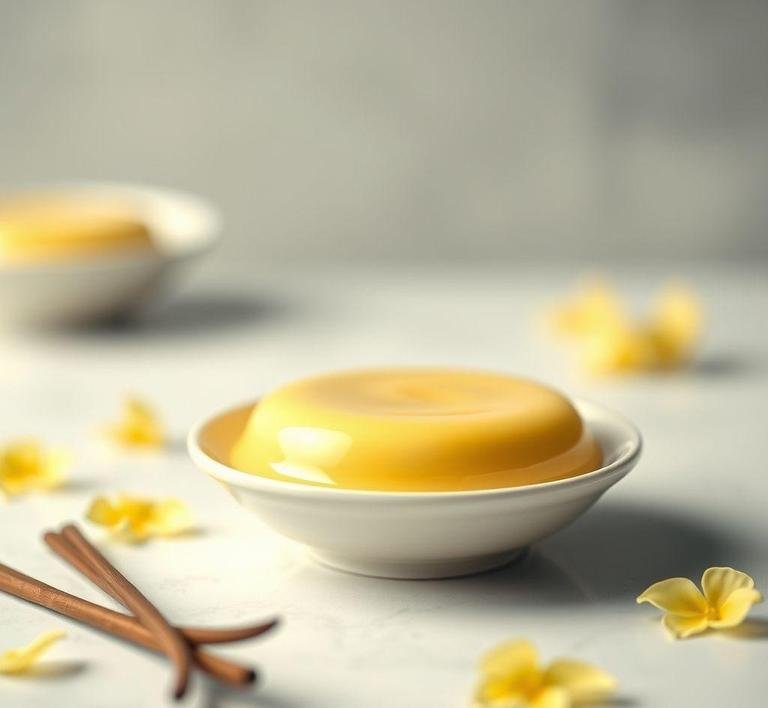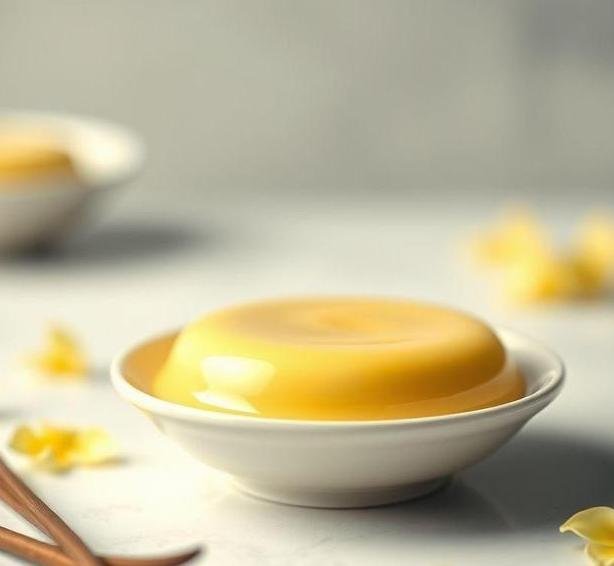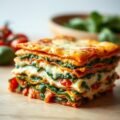Mary Berry’s Vanilla Custard is a rich, smooth, and silky crème anglaise-a traditional English pouring custard-made from simple ingredients: milk, cream, egg yolks, sugar, and vanilla. What elevates it from ordinary to extraordinary is the technique and balance. Unlike store-bought versions that can sometimes be overly thick, artificial-tasting, or overly sweet, Mary Berry’s custard is all about refined flavor and perfect consistency.
It’s meant to be lusciously smooth-thick enough to coat the back of a spoon, but not so dense that it becomes pudding-like. When made right, it’s a delicate, soothing addition that enhances rather than overwhelms a dessert. Think of it as the velvet curtain that opens onto the main stage of your dessert plate.
Mary Berry’s Vanilla Custard Recipe
Ingredients Needed

Let’s start with the ingredients. Nothing too fancy here, but it’s important that what you use is fresh and high quality. Each element plays a significant role in the final flavor and texture.
- 500 ml whole milk – This forms the body of the custard. Whole milk adds richness, but not so much that it overshadows the other ingredients.
- 100 ml double cream (heavy cream) – Adds indulgence and a silky texture.
- 1 vanilla pod or 1½ teaspoons of vanilla extract – Vanilla is the soul of this custard. A real pod, split and scraped, offers those beautiful specks and a deep floral aroma.
- 4 large egg yolks – The yolks are the magic-makers. They thicken the custard and give it that lovely golden hue.
- 50 g caster sugar (superfine sugar) – Just enough to sweeten without becoming cloying.
Optional but useful:
- A pinch of salt – This tiny addition can sharpen and round out the sweet flavor profile.
Equipment Needed
Before you begin, gather the right tools. Custard isn’t hard to make, but timing and control are everything.
- Heavy-based saucepan – Helps distribute heat evenly to avoid scorching.
- Heatproof mixing bowl
- Whisk – A balloon whisk works best for keeping the custard smooth.
- Fine sieve – For straining any lumps or curdled bits.
- Measuring jug
- Rubber spatula or wooden spoon – For gentle stirring.
- Small knife – For splitting the vanilla pod.
- Thermometer (optional) – Great for precision. Ideal custard thickens around 80-82°C (176-180°F).
Instructions To Make Mary Berry’s Vanilla Custard
1. Infuse The Milk
Pour the milk and cream into your heavy-based saucepan. If you’re using a vanilla pod, split it lengthwise and scrape out the seeds. Add both seeds and pod to the milk mixture. Bring it just to a simmer-look for tiny bubbles around the edge-but don’t let it boil. Remove from the heat and allow it to infuse for 10-15 minutes.
Tip: This infusion step is key! It allows the vanilla to fully flavor the milk, creating that deep, nuanced taste that’s signature to this custard.
2. Whisk The Yolks And Sugar
While the milk is infusing, place the egg yolks and sugar in a bowl. Whisk vigorously until the mixture becomes pale, light, and fluffy. This also helps prevent the yolks from scrambling when the hot milk is added.
3. Temper The Egg Yolks
Slowly pour the warm milk into the yolk mixture, whisking constantly. This is known as tempering-gradually increasing the yolks’ temperature so they don’t cook too fast. Discard the vanilla pod if you used one.
4. Cook The Custard
Pour the custard base back into the saucepan. Set it over low heat and stir constantly with a spatula or wooden spoon, making sure to reach the corners of the pan. Continue gently stirring until the mixture thickens and coats the back of the spoon. If you’re using a thermometer, aim for 80-82°C (176-180°F).
Visual cue: When you draw your finger across the back of the custard-coated spoon, the line should hold.
5. Strain And Cool
Once thickened, immediately strain the custard through a fine sieve into a clean bowl. This removes any tiny cooked egg bits and ensures a perfectly silky texture. You can serve it warm or let it cool down completely if using it for trifles or layered desserts.
Tips And Tricks
- Don’t rush the cooking process. Patience is your best friend here. High heat will curdle the eggs. Keep it low and steady.
- Use a thermometer if you’re not confident with visual cues-it takes the guesswork out.
- Avoid over-whisking the eggs and sugar when combining with milk. Too many bubbles can lead to a frothy, uneven texture.
- Leftovers? Pour into ramekins, chill, and serve as a simple dessert with fresh fruit or a dollop of whipped cream.
- Reheating tip: Gently reheat over a double boiler or in the microwave in short 10-second bursts, stirring frequently to prevent splitting.
- Flavor twist: Add a bit of orange zest or a splash of rum or brandy for a festive spin.
Mary Berry’s Vanilla Custard is a masterclass in simplicity and elegance. It’s more than just a sauce-it’s a foundational component in classic British desserts, from jam roly-poly to steamed puddings and summer trifles. Learning to make it properly is like acquiring a culinary superpower. With the right technique and a little patience, you’ll have a custard that’s creamy, rich, and bursting with the unmistakable warmth of vanilla.
So next time you’re looking to elevate your dessert game, skip the carton and reach for your whisk. Mary Berry would definitely approve.
Easy Recipe Variations For Mary Berry’s Vanilla Custard

Mary Berry’s vanilla custard is already a gem-smooth, creamy, and infused with the warm, delicate aroma of vanilla. But once you’ve mastered the basic technique (egg yolks, sugar, milk, cream, and real vanilla-ideally from a pod or quality extract), it’s easy to riff on this classic in a variety of creative and delicious ways. Here are some exciting twists:
1. Chocolate Swirl Custard
Craving something a little more indulgent? Once your custard is cooked and thickened, stir in a few ounces of finely chopped dark chocolate. Let it melt gently for a rich, velvety chocolate custard. You can swirl the chocolate in lightly for a marbled effect or fully combine for an all-out chocolate experience.
2. Spiced Custard
Give your custard a seasonal flair by adding spices. Think ground cinnamon, nutmeg, or cardamom. These warm spices pair beautifully with the vanilla base and create a custard that feels cozy and comforting-perfect for autumn or winter puddings. Add the spices to the milk as it heats to let the flavors infuse properly.
3. Citrus-Infused Custard
Add a bright note by incorporating citrus zest. A touch of lemon or orange zest added during the milk-warming stage adds a refreshing zing. It’s subtle, but it elevates the custard’s flavor, especially when paired with berries or a light sponge cake.
4. Boozy Twist
For a grown-up dessert, stir in a splash of your favorite liqueur after the custard has cooked. Amaretto, Grand Marnier, or even a touch of Irish cream can transform the flavor and add complexity. Just be careful not to add too much-you want to enhance, not overpower.
5. Dairy-Free Version
Want a plant-based alternative? Swap the milk and cream for a rich oat milk or coconut milk blend. Use cornstarch as a thickener instead of egg yolks for a vegan option. Add a touch of turmeric for color, and don’t skip on the vanilla-it’s what ties it all together.
Storing Leftovers
If you’ve managed to resist eating the entire batch of custard (kudos to you!), proper storage ensures it stays luscious for days. Here’s how to do it right:
Refrigerating
Cool the custard to room temperature first, then transfer it into an airtight container. Press a piece of plastic wrap directly onto the surface before sealing the lid-this prevents a skin from forming. It will keep well in the fridge for up to 3 days.
Freezing
Technically, yes-you can freeze custard, but be warned: the texture may change. Custards that rely on eggs tend to split or become grainy when thawed. If you must freeze it, pour the cooled custard into a freezer-safe container, leaving some space at the top for expansion. When ready to use, thaw in the fridge overnight and whisk it thoroughly to revive the texture. A quick blend in a food processor can also help smooth things out.
Reheating
Gently reheat the custard in a saucepan over low heat, stirring constantly. Avoid high heat, which can cause curdling. If it thickens too much, add a splash of milk to loosen it to your desired consistency.
What To Eat With Mary Berry’s Vanilla Custard?
The real beauty of vanilla custard lies in its incredible versatility. It plays well with so many textures and flavors that it can elevate even the simplest dish into something special. Here are some top-tier pairing ideas:
Fruit Crumbles And Pies
A classic pairing! Pour warm custard over apple crumble, rhubarb crisp, or a berry-laden cobbler. The hot fruit and crunchy topping meet the smooth custard in a divine union of textures.
Steamed Puddings
Think treacle sponge, jam roly-poly, or sticky toffee pudding. These dense, hearty British puddings just cry out for a generous ladle of custard to balance their sweetness and richness.
Fresh Berries
In summer, serve the custard chilled alongside fresh strawberries, raspberries, or blueberries. It’s light, elegant, and refreshing-almost like a simplified trifle.
Poached Fruits
Pear halves poached in red wine or apples cooked with cinnamon pair beautifully with custard. The combination of soft, spiced fruit and smooth custard feels comforting and luxurious.
Pastries And Tarts
Use the custard as a base for a tart-pour into a baked pastry shell, chill until set, and top with glazed fruit for a patisserie-style dessert. Or simply serve alongside croissants or brioche for a continental twist.
Plain And Simple
Honestly? A bowl of vanilla custard on its own-warm or cold-is a deeply satisfying dessert. Add a sprinkle of nutmeg or cinnamon, and you’re golden.
Conclusion
Mary Berry’s vanilla custard is a masterclass in simplicity-a silky, gently sweetened canvas that invites both classic accompaniments and bold variations. Whether you’re sticking to tradition or experimenting with flavors, this custard offers endless possibilities. It’s nostalgic and indulgent, humble yet elegant. From spiced fall versions to citrus-bright summer renditions, from crumble toppers to tart fillers, its versatility is unmatched.
So, the next time you whip up a batch of this golden delight, don’t just stop at the basics. Stir in something daring. Pour it over something unexpected. Or simply savor it slowly, spoon by silky spoon. After all, as Mary Berry herself might say, there’s nothing quite like homemade custard to make everything feel a bit more special.
FAQs
What Are The Key Ingredients For Mary Berry’s Vanilla Custard?
Mary Berry’s vanilla custard recipe requires basic ingredients such as whole milk, double cream, vanilla extract, egg yolks, caster sugar, and cornflour. These ingredients work together to create a smooth, rich custard with a perfect balance of sweetness and vanilla flavor.
How Do I Prevent The Custard From Curdling When Making Mary Berry’s Recipe?
To avoid curdling, it’s essential to heat the milk and cream mixture gently over low heat, stirring constantly. When adding the hot milk to the egg mixture, make sure to temper the eggs by gradually pouring in a little of the hot liquid while whisking constantly, preventing the eggs from cooking too quickly. Once combined, return the mixture to the pan and cook over low heat until thickened.
Can I Make Mary Berry’s Vanilla Custard Ahead Of Time?
Yes, you can make Mary Berry’s vanilla custard ahead of time. Once the custard has cooled to room temperature, store it in an airtight container in the refrigerator for up to two days. To prevent a skin from forming on top, you can place a piece of cling film directly on the surface of the custard. When ready to serve, simply reheat gently over low heat, stirring occasionally.


